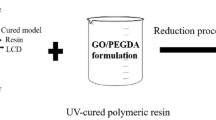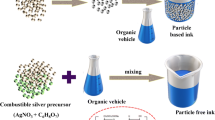Abstract
Printing of metal oxides at low temperatures is highly challenging, and highly reactive metalorganic inks have been investigated to achieve the target material using process conditions below 150 °C. Unfortunately, their reactivity prohibits facile handling along with making treatment with water to form sol–gels impossible to control and so glyme additives have been investigated to reduce sensitivity without compromising printed material conversion to metal oxide. In this paper, we report addition of a range of glymes to ink formulations and an assessment of the stability enhancement achieved through a range of exposure trials. A clear improvement in air/moisture stability is demonstrated in all cases. Evaluation of the thermal requirements to remove an organic material with and without the additives has been performed with diglyme, proving to be the optimum stabilisation agent leading to minimal change in the process conditions required. Further studies with additional metal doping is planned to enable transparent conducting coatings to be fabricated at low temperatures on flexible plastic substrates.











Similar content being viewed by others
References
Gerard C, Marc PY D (2012) Inkjet printing of conductive materials: a review. Circuit World 38(4):193–213. doi:10.1108/03056121211280413
Bright CI (2007) Review of transparent conductive oxides (TCO). In: Mattox DM, Mattox VH (eds) 50 years of vacuum coating technology and the growth of the society of vacuum coaters, Ch. 7. Society of Vacuum Coaters. ISBN 978-1-878068-27-9
BCC Research report (2016) http://www.bccresearch.com/pressroom/avm/transparent-conductive-coatings-market-expanding-as-applications-soar. Accessed 27 Dec 2016
Derby B, Reis N (2003) Inkjet printing of highly loaded particulate suspensions. MRS Bull 28(11):815–818. doi:10.1557/mrs2003.230
Zhidong P, Yanmin W, Huining H, Zhiyuan L,Yonggang D, Shanjun K (2015) Recent development on preparation of ceramic inks in ink-jet printing. Ceram Int 41(10):12515–12528. doi:10.1016/j.ceramint.2015.06.124. A
Robert MP, David SG, Ryan O (2011) Solution processing of transparent conductors: from flask to film. Chem Soc Rev 40:5406–5441. doi:10.1039/C1CS15065K
INFINITY project website (2014) https://infinity-h2020.eu/. Accessed 11 Nov 2016
Tang S, Zhao H (2014) Glymes as versatile solvents for chemical reactions and processes: from the laboratory to industry. RSC Advances 4(22):11251–11287. doi:10.1039/C3RA47191H
Acknowledgements
This work was funded by European Union’s Horizon 2020 research and innovation programme under grant agreement No 641927 (INFINITY project).
Author information
Authors and Affiliations
Corresponding author
Ethics declarations
Conflict of interest
The authors declare that they have no competing interest.
Rights and permissions
About this article
Cite this article
Fleming, B., Rushworth, S. Investigation of glyme additives to metalorganic ink systems. J Sol-Gel Sci Technol 82, 308–314 (2017). https://doi.org/10.1007/s10971-017-4302-6
Received:
Accepted:
Published:
Issue Date:
DOI: https://doi.org/10.1007/s10971-017-4302-6




